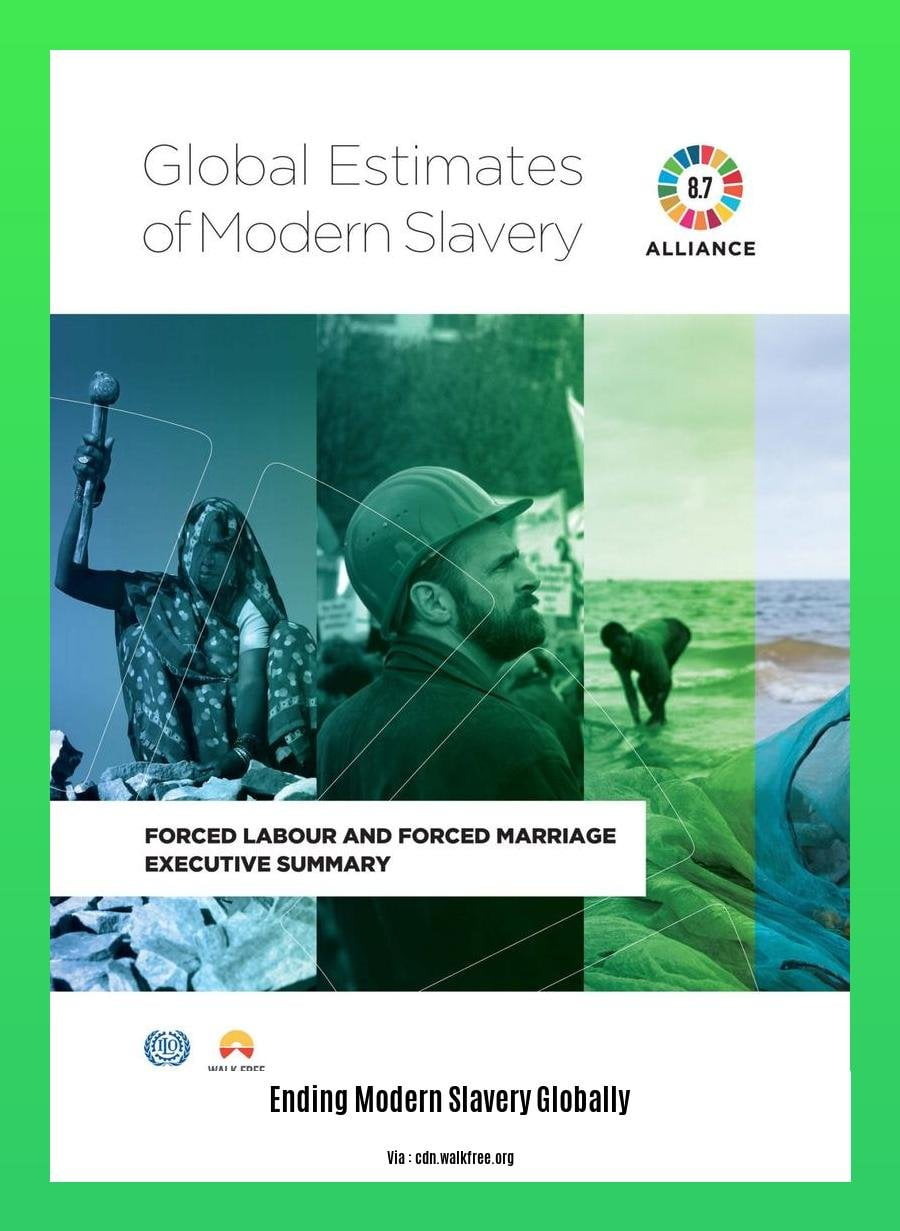Ending Modern Slavery Globally: Imperative Steps Toward Eradication | Modern Slavery Statistics 2021

Key Takeaways:
- Modern slavery affects 40.3 million people globally.
- 24.9 million people are trapped in forced labor.
- One out of every four victims of modern slavery is a child.
- 62% of modern slavery cases involve forced labor, while 38% involve forced marriages.
- The Global Fund to End Modern Slavery (GFEMS) was established in 2017.
- The Modern Slavery Act (U.K.) aims to crack down on businesses but lacks support for child victims.
- Despite global efforts, the problem of modern slavery has not improved significantly.
Ending Modern Slavery Globally
Modern slavery is a global crisis, but it’s not insurmountable. Here are crucial steps towards ending modern slavery globally:
1. Increase Awareness
Public awareness of modern slavery is essential. We must educate ourselves, our communities, and our leaders about its existence, extent, and impact.
2. Strengthen Laws
Governments must create and enforce robust laws that punish perpetrators of modern slavery and protect victims. Penalties must be severe enough to deter trafficking and prevent individuals from profiting from exploitation.
3. Support Survivors
Victims of modern slavery need comprehensive support to rebuild their lives. Governments and organizations must provide physical, psychological, and economic assistance to help them recover and reintegrate into society.
4. Corporate Responsibility
Businesses have a critical role in eradicating modern slavery. They should develop and implement policies to ensure their supply chains are free from forced labor and forced marriage.
5. International Cooperation
Modern slavery is a global issue that requires a global response. All countries must work together to share information, strengthen laws, and coordinate efforts to dismantle criminal networks.
6. Empower Communities
Prevention and community involvement are crucial. Empowering at-risk communities through education, income-generating opportunities, and legal protection can help prevent individuals from falling prey to traffickers.
7. Technological Advancements
Technology can be harnessed to combat modern slavery, such as data analytics for identifying and tracking traffickers and mobile apps for victims to access help.
8. Invest in Education
Education is key to preventing and ending modern slavery. It empowers individuals with the knowledge and skills to protect themselves and others from exploitation.
By taking these steps, we can create a world where modern slavery is a thing of the past.
- Eliminating global forced labor practices is a crucial step in eradicating international human trafficking networks and stopping worldwide exploitation of workers.
Modern Slavery Statistics: Unveiling the Global Scourge
Modern slavery, a heinous crime that enslaves millions worldwide, is a harrowing reality that demands our urgent attention. Recent Modern Slavery Statistics paint a grim picture, revealing the alarming prevalence and devastating consequences of this scourge.
Key Takeaways:
- An estimated 50 million individuals are ensnared in the clutches of modern slavery globally, a staggering surge of 10 million since 2016. (UN, Walk Free)
- Women and children, often the most marginalized, bear the brunt of this exploitation, accounting for a disproportionate number of victims. (UN)
- Forced labor, a key facet of modern slavery, involves coercing individuals into unpaid or underpaid work under conditions of abuse. (Walk Free)
- Forced marriage, another abhorrent form of exploitation, robs individuals of their autonomy and choice. (International Labour Organization)
- Modern slavery’s tentacles reach every corner of the globe, affecting countries across all regions. (Statista)
- The United States alone is estimated to have over 400,000 individuals living in modern slavery. (Guardian)
These harrowing Modern Slavery Statistics highlight the urgent need for action. Governments, organizations, and individuals must collaborate to combat this scourge, protect vulnerable populations, and create a world free from modern slavery. The fight against this injustice demands our unwavering commitment and determination.
Citation:
– United Nations Office on Drugs and Crime:

FAQ
Q1: What is the current state of modern slavery globally?
A1: Modern slavery continues to be a pervasive issue worldwide, with an estimated 50 million people currently trapped in its clutches. Children and women are disproportionately vulnerable to exploitation and forced marriage.
Q2: What are the key steps needed to eradicate modern slavery?
A2: Ending modern slavery requires a multifaceted approach that includes addressing root causes, strengthening legislation, enhancing enforcement, and fostering international cooperation. Governments, organizations, and individuals must work together to combat human trafficking and protect vulnerable populations.
Q3: What are the challenges in eradicating modern slavery?
A3: Eradicating modern slavery is a complex task due to its hidden nature, the diversity of its forms, and the involvement of organized crime networks. Poverty, inequality, and conflict also contribute to the vulnerability of individuals to exploitation.
Q4: How can we contribute to ending modern slavery?
A4: Individuals can play a vital role in the fight against modern slavery by raising awareness, supporting organizations working to combat it, and making ethical consumption choices. Educating oneself about the issue is also crucial.
Q5: What are the recent developments in the fight against modern slavery?
A5: Recent years have seen increased attention to modern slavery, with several governments implementing stricter legislation and international organizations launching initiatives to combat it. The Global Fund to End Modern Slavery (GFEMS) is one significant initiative mobilizing resources and partnerships to tackle this issue.










